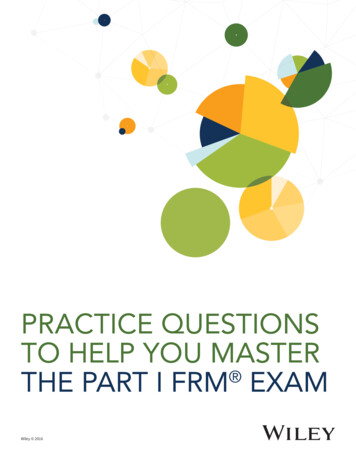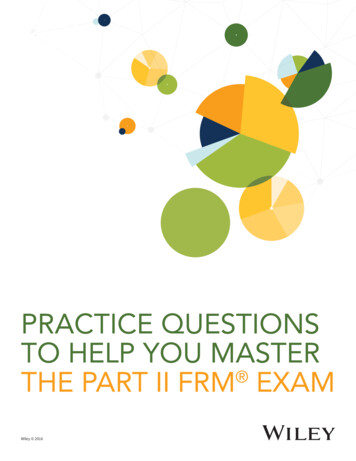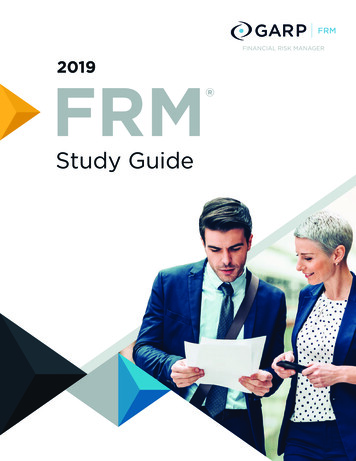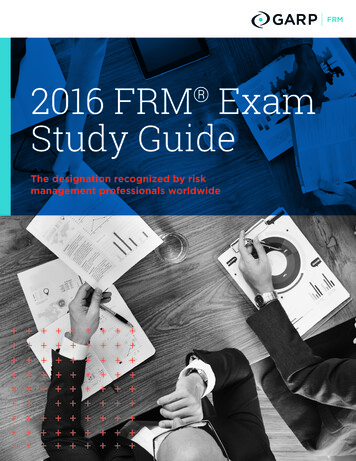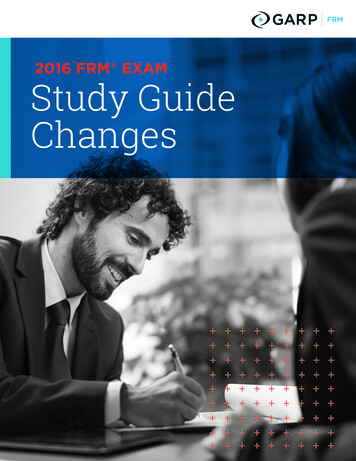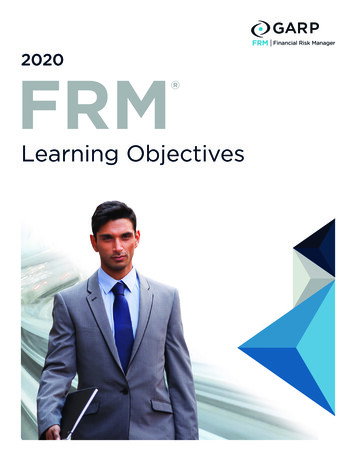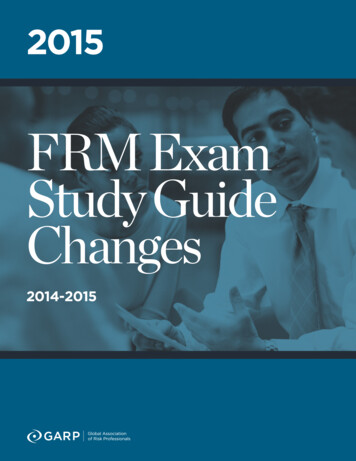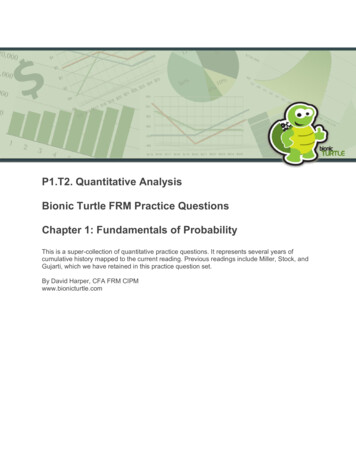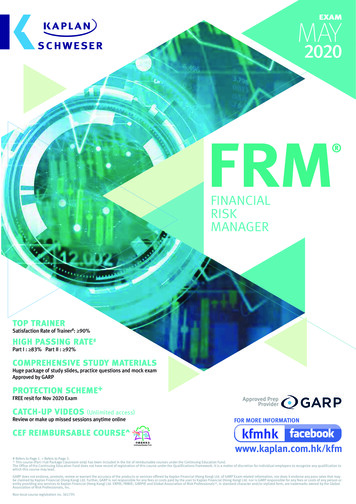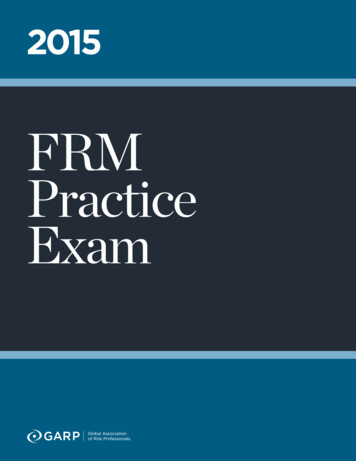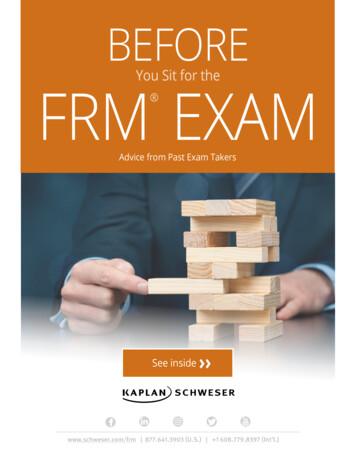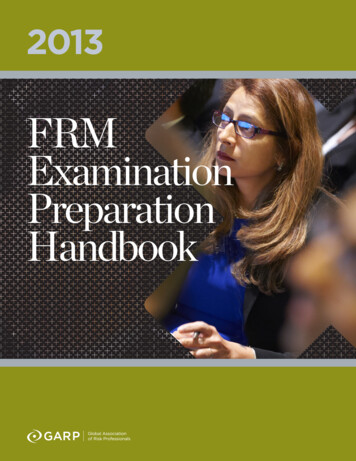
Transcription
2013FRMExaminationPreparationHandbook
2013 Financial Risk Manager (FRM ) Exam Preparation HandbookSuggested Study Strategies for theOn an annual basis, GARP’s FRM Commit-FRM Examinationtee, comprised of leading risk managementprofessionals and academics, establishesThe purpose of this handbook is to assistthe topic areas to be tested in the FRMFinancial Risk Manager (FRM ) candidatesExamination. The topic areas so determinedin their preparation for the FRM Examina-are then published in the FRM Study Guide.tion by suggesting strategies for completingMore detailed Knowledge Points associatedthe reading material outlined in the FRMwith these topic areas are contained in theStudy Guide and FRM AIM StatementsFRM AIM Statements, which are also pub-documents, which together form the blue-lished and made available to registeredprint for exam topic coverage.FRM candidates.About the FRM ExaminationPreparation for the ExamThe FRM Examination is a practice-orientedThe FRM Exam is a self-study program.exam offered by GARP (the Global Associa-In past exams, the typical successful FRMtion of Risk Professionals) and designed tocandidate reports to have studied betweenassess a candidate’s knowledge and under-200–400 hours. The exact amount of timestanding of the skills necessary to functionthat is appropriate for any specific candi-effectively as a financial risk manager.date will, however, vary from candidate tocandidate depending on factors such asGARP is governed by a Board of Trusteeswork experience and knowledge base ofcomprised of top risk professionals andrisk management and finance.academics from around the world. As aprofessional association with global mem-Due to the sizeable amount of materialbership and an extensive professional andcovered in the exam, it is important that aacademic chapter network, GARP is in acandidate create a weekly study scheduleunique position to ascertain standards andthat is designed to spread out learningassess evolving trends in risk managementof the material over an extended period.practices. To calibrate and benchmark itsCramming for the exam in the few weeksunderstanding of the demands of the globalleading up to it is not recommended. In thisrisk management community, GARP alsopreparation handbook, we recommend aconducts formal job task analysis surveys tostudy plan for each part of the FRM Exami-determine the knowledge, skills and abilitiesnation. Each plan is split into 20 sessionsrequired to function effectively as a finan-intended to serve as a blueprint for thecial risk manager around the world.candidate in structuring their own scheduleand pacing themselves for the exam.The purpose of this handbook is to assist FRM candidates in their preparation for the FRM Examinationby suggesting strategies for completing the reading material outlined in the FRM Study Guide and FRM AIMStatements documents, which together form the blueprint for exam topic coverage. 2013 Global Association of Risk Professionals. All rights reserved.1
2013 Financial Risk Manager (FRM ) Exam Preparation HandbookStudy GuideThe Study Guide contains a full listing of all the readings that are recommended as preparationfor the FRM Examination. In addition, Key Concepts appear as bullet points at the beginning ofeach section of the Study Guide and are intended to help candidates identify the major themesand knowledge areas associated with a particular section.AIM Statementsand Practice ExamsThe AIM Statements contain all of the suggested readings and Key Concept information thatare in the Study Guide as well as more detailed Knowledge Points that form the basis for theFRM Examination questions. To facilitate a candidate’s preparation, each Knowledge Point inthe AIM Statements is associated with a suggested reading from the Study Guide which supports and explains it. Candidates who compare the Key Concepts to the Knowledge Points willnote that in most cases several Knowledge Points are related to each broader Key Concept.Thorough preparation for the Examination based on the readings listed in the Study Guide,focused on an understanding of the Knowledge Points described in the AIM Statements isstrongly recommended.FRM ExamStructureThe FRM Examination consists of two parts—Part I and Part II—that are both offered twice ayear on the third Saturday of May and November. Part I is an equally-weighted 100 questionmultiple-choice exam offered in the morning of the exam day and Part II is an equallyweighted 80 question multiple-choice exam offered in the afternoon of the exam day.Both Part I and Part II have a maximum allowable time for completion of four hours. It isimportant to note that Part I and Part II of the FRM Examination must be passed sequentially.Therefore, while it is possible to sit for both parts of the Examination on the same day, acandidate must receive a passing score on Part I of the Examination before GARP will scorehis or her Part II Examination. Most candidates elect to take Part I and Part II on separateexam administration days.Part I of the FRM Examination covers the fundamental tools and techniques used in riskmanagement and the theories underlying their use. Specific areas of coverage and theirweighting in the exam are:Foundations of Risk Management (20%). This area focuses on a candidate’s knowledge offoundational concepts of risk management and how risk management can add value to anorganization. An understanding of the trade-off between risk and return, the construction ofefficient portfolios, fundamental asset pricing models, and enterprise risk management frameworks are covered. To ensure that important lessons from history are not lost, a review ofmajor financial disasters from the past is included in this section. To emphasize the importanceof ethics as a fundamental requirement for sound risk management, applications of the GARPCode of Conduct to professional situations are covered in this section as well.Quantitative Analysis (20%). This area tests a candidate’s knowledge of basic probability andstatistics, regression and time series analysis, and various quantitative techniques useful in riskmanagement such as Monte Carlo methods and volatility forecasting models.2 2013 Global Association of Risk Professionals. All rights reserved.
2013 Financial Risk Manager (FRM ) Exam Preparation HandbookFRM ExamStructureFinancial Markets and Products (30%). This area tests the candidate’s knowledge of financialproducts and the markets in which they trade, including equities, commodities, currencies,fixed income, equity options and other derivatives. A basic understanding of arbitrage arguments related to the valuation of financial products in these markets is also tested.Valuation and Risk Models (30%). This area will test a candidate’s knowledge of valuationtechniques and risk models. This includes coverage of basic bond valuation, valuation usingbinomial trees, and an understanding of the Black-Scholes-Merton model. Risk models andtechniques such as Value-at-Risk, the contingent claims approach to measuring risk, expectedand unexpected loss estimation, and stress testing are also covered.Part II of the exam further applies the tools and techniques covered in Part I and delves moredeeply into major sub-areas of risk management. Specific areas of coverage include:Market Risk Management (25%). This section tests a candidate’s knowledge of market riskmeasurement and management techniques. These include term structure models for fixedincome securities and volatility exposures. The risk measures covered include Value-at-Risk,expected shortfall, and several other coherent measures. An understanding of correlations andcopulas, the usage of parametric and non-parametric estimation methods, and extreme valuetheory is also expected. Exotic options and mortgage backed securities are also covered inthis section.Credit Risk Management (25%). This area focuses on the candidate’s understanding of creditrisk management with some focus given to structured finance and credit products such ascollateralized debt obligations and credit derivatives. Knowledge of the subprime mortgagecrisis and counterparty risk is also tested as well as default risk and methodologies used tomeasure it, such as Credit VaR.Operational and Integrated Risk Management (25%). This area addresses a candidate’sknowledge of two areas of increasing importance for many firms—operational risk management and integrated risk management. This includes coverage of the tools and techniquesnecessary to measure, manage, and mitigate operational risk, estimation of economic capitalneeds, and risk-based capital allocation. Knowledge of critical issues related to liquidity riskmanagement, model risk, the back-testing of Value-at-Risk models, and stress testing areexamined. Importantly, this section also tests a candidate’s knowledge of key Basel regulations—one of the major international regulatory frameworks relevant to risk managers today.Risk Management and Investment Risk Management (15%). This area focuses on a candidate’sknowledge of risk management techniques applied to the investment management process.Topics such as portfolio construction and performance analysis are covered as well as riskbudgeting and portfolio and component VaR. Issues related to hedge funds and private equityinvestments are also covered. 2013 Global Association of Risk Professionals. All rights reserved.3
2013 Financial Risk Manager (FRM ) Exam Preparation HandbookFRM ExamStructureCurrent Issues in Financial Markets (10%). The candidate is expected to familiarize himself/herself with the readings from this section, approaching each paper critically as a risk managerequipped with the knowledge from the other sections. This area of the exam will test a candidate’s knowledge of the material covered by each paper.FRM BooksWhile there are no requirements for a candidate to acquire the readings listed in the StudyGuide, it is strongly recommended. Proper preparation for the Examination without the information contained in these readings would be extremely difficult. To facilitate candidates’preparation, all of the readings listed and described in the FRM Study Guide are availablethrough GARP. Beginning in 2011, all of the Part I readings were made available to candidatesin four bound books, known as the FRM Part I Books, each book associated with a separatePart I Examination section. Beginning with the May 2013 FRM registration cycle, all of the PartII readings (with the exception of Current Issues and the Readings for Regulatory Reference)will be available in bound FRM Part II Books. Some of the readings, including all the readingsin the Current Issues and Regulatory Reference sections, are also freely available on theGARP Digital Library. Further information about the FRM Part I and Part II Books can befound at ls.aspx.Candidates are strongly encouraged to download and take the FRM Practice Exams from thePractice ExamsGARP website at s.aspx. While not everyreading referenced in the practice exams is currently being used on the FRM Examination,the underlying concepts remain largely the same and the practice exams will provide candidates with a good sense of the question types to expect when sitting for the actual FRMExamination, and will allow the candidate to estimate how much time they can expect tospend answering individual questions. The practice exams also include an explanation for eachcorrect answer so that candidates can better understand their incorrect replies and identifyareas of weakness that need emphasis.The dialect used by the examination is American English. GARP is aware that not every FRMLanguage andMathematicalPrerequisitescandidate has American English as his or her native dialect. In the exam development process,GARP strives to ensure that questions are written in a clear, concise form and avoids the useof colloquialisms or other terms and phrases that might confuse a non-native AmericanEnglish speaker.The level of mathematical rigor of the Examination is consistent with an advanced undergraduate or introductory graduate level finance course at most universities.4 2013 Global Association of Risk Professionals. All rights reserved.
2013 Financial Risk Manager (FRM ) Exam Preparation HandbookStudy GroupsGARP strongly encourages candidates to form study groups (if possible) so that they mayprepare for the Examination with others. Study groups are a great way for candidates to sharethe study load while helping each other with topics where individuals may have a weakness;it is also a good way to meet fellow FRM candidates. We encourage candidates to use boththe official FRM Facebook and LinkedIn web pages to find or form local study groups for theFRM Examination.Finally, there are a number of third-party exam prep providers (EPPs) who offer FRMExamination preparation courses for candidates who feel they may benefit from such aprogram. A list of EPPs that have registered with GARP can be found at ion-providers.aspx. Please note: GARP does not endorse,promote, review or warrant the accuracy of the products, services, or information offeredby EPPs nor does it endorse any pass rates claimed by them.Calculator PolicyOnly the following types of business calculators are authorized for use on the Examination: Hewlett Packard 12C (including the HP 12C Platinum and the Anniversary Edition) Hewlett Packard 10B II Hewlett Packard 10B II Hewlett Packard 20B Texas Instruments BA II Plus (including the BA II Plus Professional)There will be no exceptions to this policy. Use of a non-authorized calculator during the examwill result in the candidate’s answer sheet not being graded, and the candidate will receiveno score for the exam. Candidates may not consult the operator’s manual for their calculatorduring the exam. Calculator memory
The FRM Examination is a practice-oriented exam offered by GARP (the Global Associa - tion of Risk Professionals) and designed to assess a candidate’s knowledge and under-standing of the skills necessary to function effectively as a financial risk manager. GARP is governed by a Board of Trustees comprised of top risk professionals and academics from around the world. As a professional .
